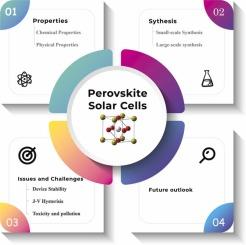打破障碍:应对包光体太阳能电池开发中的挑战
IF 6.3
2区 材料科学
Q2 CHEMISTRY, PHYSICAL
引用次数: 0
摘要
近十多年来,透镜材料因其高功率转换效率(PCE)而备受研究人员的关注。这些材料具有优异的化学和物理特性,是生产太阳能电池的理想材料。在小规模生产中,可采用各种方法合成过氧化物晶石,如双源气相沉积、一步法和两步法溶液沉积、气相辅助溶液沉积以及连续沉积技术。在大规模生产方面,工业界采用了喷墨打印、滴铸、叶片镀膜、槽模镀膜和喷涂等技术。尽管包光体太阳能电池潜力巨大,但在商业化方面却面临着巨大的挑战,主要原因是化学稳定性问题,其化学稳定性只能维持几个月。因此,近期的研究重点是改善薄膜形成和界面工程,以提高器件的 PCE 和稳定性。要实现商业化,关键是要通过封装、界面工程和湿度控制等材料稳定性改进措施,解决湿气和紫外线等环境因素造成的降解问题。这就需要开发标准化的稳定性测试和优化条件,以实现最佳性能。本综述旨在深入探讨包晶石结构的复杂性及其小规模和大规模制造技术。本综述还批判性地探讨了在将过氧化物晶体商业化方面所面临的挑战和障碍。最后,这篇综述深入探讨了实现包晶体太阳能电池高 PCE 的未来战略,强调需要先进的材料工程、稳健的封装技术以及可扩展、具有成本效益的沉积方法,以提高器件的稳定性、防潮性和整体使用寿命,从而为基于包晶体的光伏技术的商业化铺平道路。本文章由计算机程序翻译,如有差异,请以英文原文为准。

Breaking Barriers: Addressing Challenges in Perovskite Solar Cell Development
Perovskites have captured the interest of researchers for over a decade due to their high-power conversion efficiency (PCE). These materials boast excellent chemical and physical properties, making them ideal for solar cell production. On a small scale, perovskites are synthesized using various methods such as dual-source vapor deposition, one-step and two-step solution deposition, vapor-assisted solution deposition, and sequential deposition techniques. For large-scale production, industries employ techniques like inkjet printing, drop casting, blade coating, slot-die coating, and spray coating. Despite their potential, perovskite solar cells face significant challenges in commercialization, primarily due to chemical stability issues to only a few months. Therefore, recent research focuses on improving film formation and interfacial engineering to enhance device PCE and stability. To move towards commercialization, it is crucial to address degradation caused by environmental factors such as moisture and UV light through material stability improvements such as encapsulation, interface engineering, and humidity control. This necessitates the development of standardized stability tests and optimized conditions for maximum performance. This review aims to delve into the intricacies of perovskite structures and their fabrication techniques on both small and large scales. It also critically examines the challenges and obstacles in commercializing perovskites. Finally, the review offers insights into future strategies for achieving high PCE in perovskite solar cells, emphasizing the need for advanced materials engineering, robust encapsulation techniques, and scalable, cost-effective deposition methods to enhance device stability, moisture resistance, and overall longevity, paving the way for the commercialization of perovskite-based photovoltaics.
求助全文
通过发布文献求助,成功后即可免费获取论文全文。
去求助
来源期刊

Journal of Alloys and Compounds
工程技术-材料科学:综合
CiteScore
11.10
自引率
14.50%
发文量
5146
审稿时长
67 days
期刊介绍:
The Journal of Alloys and Compounds is intended to serve as an international medium for the publication of work on solid materials comprising compounds as well as alloys. Its great strength lies in the diversity of discipline which it encompasses, drawing together results from materials science, solid-state chemistry and physics.
 求助内容:
求助内容: 应助结果提醒方式:
应助结果提醒方式:


